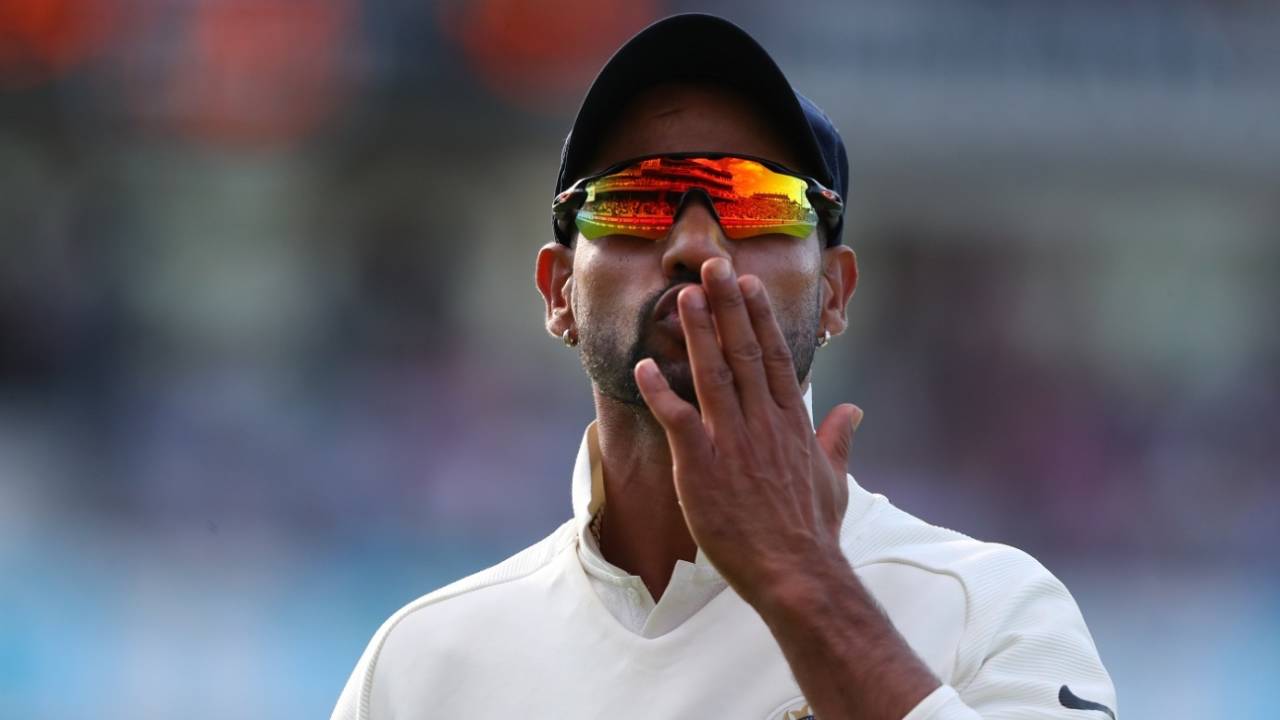Where now for Shikhar Dhawan?
With an average of 25.80 from 15 Tests in South Africa, England, New Zealand and Australia, should he continue being one of India's first-choice openers?
Ankur Dhawan
14-Sep-2018
Getty Images
After another overseas defeat, India find themselves in a quandary. What to do about Shikhar Dhawan? A prolific run-getter at home, Dhawan has struggled to make the same kind of impact on the road, in conditions where the ball moves as though it has legs and a mind of its own. He finished the England series with a top score of 44 in eight innings, which meant the middle order was exposed to the new ball far too often.
It wasn't for lack of effort, but there were no tangible rewards for Dhawan. Dropped at Lord's following two dismissals to loose strokes in the first Test at Edgbaston, he came back with a changed approach, and tried hard to play close to his body and resist the temptation to drive on the up when the carrot was dangled. Inevitably, though, Instinct prevailed over discipline, and even after getting his eye in at the Ageas Bowl, he was lured into poking at deliveries in the channel outside off stump, either driving away from his body or defending on the walk.
The most successful team in England over the last decade or so has been South Africa. For all the talent that ran through their middle order, their backbone was their captain and opener Graeme Smith, who scored the ugly runs, which allowed the Amlas and de Villiers to score the pretty ones. That's not to say Amla and de Villiers didn't score tough runs, only that Smith's solidity gave them more freedom against a usually older ball. Dhawan has generally shown a brittleness incongruent to seeing off the shine.
Virat Kohli's India discovered the value of a solid opening stand in Nottingham, the only time the openers blunted the new ball in both innings, putting on 60 both times. It was no surprise that those starts were followed by middle-order partnerships of 159 and 113.
In Southampton, however, old maladies resurfaced for Dhawan - perhaps because they had never really gone away.
At the beginning of India's previous cycle of overseas tours, in early 2014, Dhawan played two of his best knocks, back to back, a century in a fourth-innings chase in Auckland and then a 98 in Wellington. The salient features of both innings were common - meditative discipline outside the off stump until the shine wore off, patience, and a desire to play as straight as possible.
The adjustments he made, however, never became habits. As a consequence, he hasn't repeated those scoring feats outside Asia (excluding the West Indies) since.
When India toured England in 2014 his outside edge and the away-moving delivery had reunited. In Nottingham, where England's No 11, James Anderson, made 81, Dhawan was caught behind pushing at a full ball from the same bowler for 12. Twice in the next four innings, Anderson squared him up, exploiting his tendency to fish at the late-moving ball without getting across with his feet to cover the line, and had him caught in the slips.
Zoom back to the just-concluded series in England, and Dhawan has been out caught by the keeper, slips or gully five times in eight innings. And while one would expect a high percentage of such dismissals among openers in these conditions, he hasn't necessarily fallen to unplayable deliveries that threatened his off stump or moved prodigiously late. They've generally been full, wide and swinging further away, luring Dhawan, who has eventually taken the bait. In the last Test at The Oval he was lbw twice, and the second-innings dismissal in particular seemed like a consequence of his struggles outside off stump: he fell over, going too far across his stumps in an attempt to cover the away movement, and was lbw to the inswinger.

Getty Images
Only once since that first innings in Wellington - when he made a second-innings 81 in Brisbane - has Dhawan managed to face 100 or more balls in an innings in the SENA (South Africa, England, New Zealand and Australia) countries. The most he has managed in England is 85 balls. In his 14 outings in England, Dhawan has faced an average of 35.93 balls per innings.
Not much seems to have changed between the previous cycle of tours and this one. The weaknesses Dhawan has shown on this tour of England are the same ones that led to India dropping him after the third Test of their previous tour here. They are the same weaknesses that cost him his place for the final Test of their Australia tour of 2014-15.
Why then was he part of the first-choice opening partnership on their tours of South Africa and England this year? Perhaps this was because India played all their Test cricket in the subcontinent or the West Indies between the previous SENA cycle and this one. In these conditions, Dhawan averaged 51.78, scoring three of his four hundreds against Sri Lanka and the other against Bangladesh.
There were accomplished innings against spin in that period, such as his first-innings hundred in Galle in 2015, but his technique against fast bowling wasn't really tested that often. On the rare occasion when he did come up against seaming conditions, as in the Kolkata Tests against New Zealand in 2016 and Sri Lanka last year, he did not entirely convince with his handling of the new ball.
Now, after the series defeats in South Africa and England, India's next Test assignment is a home series against West Indies. It could be another chance for Dhawan to score runs in conditions where his technique won't really be scrutinised to the fullest, but India will have to be mindful that a sterner test awaits them thereafter: in Australia, against one of the best pace attacks in the world.
